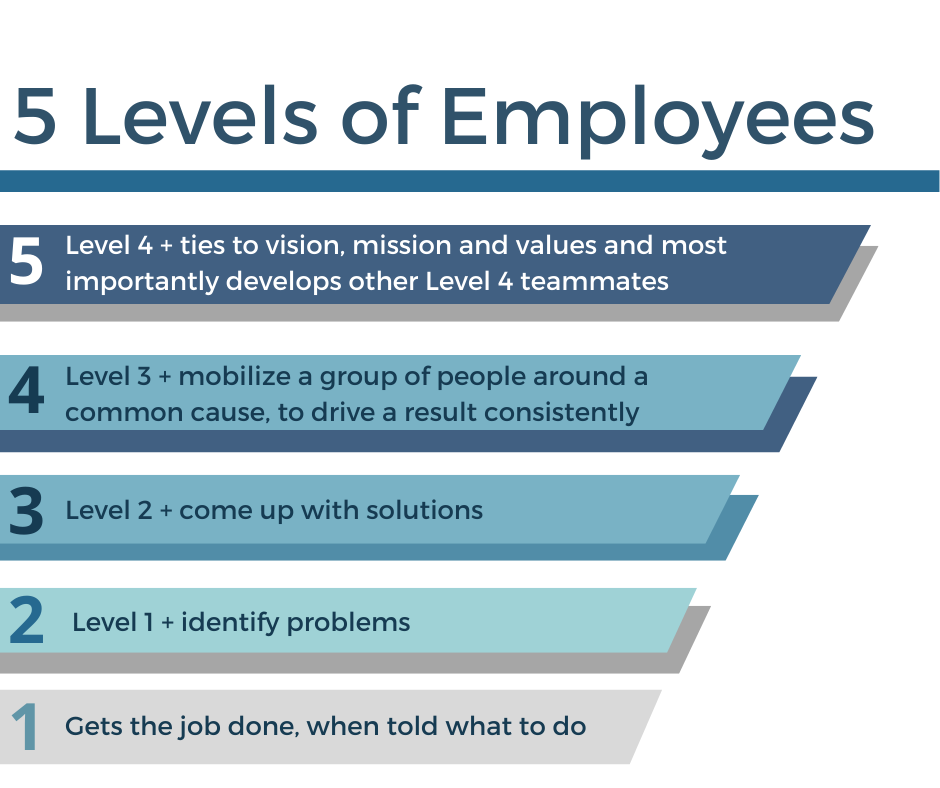Rank your employees from basic skills to MVPs, then focus on how to help them level up.
Written for Farm Futures and originally published at https://www.farmprogress.com/commentary/how-assess-your-teams-performance on 6/27/2022.
Gone are the days when employees were cheap and easy to come by. Labor, including working with family, is always one of the top three concerns in our transition planning meetings. It’s hard to move ahead and transition the farm without a plan of both family and outside family labor.
Owners’ time is precious, and we’ve found certain employee activities drain that time. Stack those time drains together, and leadership ends up managing the daily whirlwind of urgent but not necessarily critical tasks.
Changes at the leadership level trickle down throughout the farm and family. There is an adage that if you want to change something, you first have to measure it. Below are five levels of employee engagement and a quick way to rate them. How would your team average if you had to rate each member on your team?

Let's look at each level and the pros and cons of each.
Level 1
Sometimes just getting the job done is a success. The job gets done when solid employees do exactly what you tell them. But, think about what happens to your day. You give them a task; they complete it and come back for another task. This interrupts your day as you try to juggle who is doing what and who will do what next. Managing employees at this level requires all your attention, so you can’t get your work done.
Level 2
These employees see when something isn’t right and alert you. For example, the manure pump sounds different, tractor is pulling hard, etc. This is good because they are paying attention. The issue is that you (the manager) are the tech support for everyones’ problems, big and small. Farms we have worked with said it was the biggest time drain, as most of the day is spent fixing everyone else’s issues.
Level 3
This level allows you to breathe a bit because your employees are solving their own issues within their own teams. As long as you keep giving them weekly/daily task lists they will perform. The challenge is staying ahead of their task lists and keeping things organized. Your time is still spent serving them, and it is still hard to get away and focus on the larger issues and opportunities of the farm.
Level 4
Level 4 team leaders drive the results of larger projects. These employees see the bigger picture, and that’s great. As long as you give clear big picture objectives and timelines, this employee will motivate and organize others to get the job done on time and at the quality you need. What this team needs to really shine are key people who will train, mentor, and build up others on the team. If the team doesn’t have such a person, all of the “people issues” will fall on your shoulders. This is often because the team leaders lack the authority or soft skills to completely lead a team.
Level 5
This is where great things happen. Employees in this realm are rare. While employees may not operate at this level, it is critical for owners and family working in the business to perform at this level. The most important part of this level is developing other employees to maximize their full potential. The skills of a leader here are mentor, coach, and trainer. These skills are especially important for family farms where the predominant labor force is family. Family farms with key employees and family at level 5 have a strong competitive advantage because many farms don’t have anyone at this level.
Now What?
The first step is taking a clear look at what level you need your employees. What level do you need your key team leaders? What level do you need yourself or your family members to operate? Once you answer those questions, you are well on your way to creating a game plan to move your employees up. There are pros and cons to each level, and not every employee needs to be a level 5 employee.
There are several tactics, but the farms we have worked with typically find ways that they, as a management team, can remove barriers, change communication or improve workflow to help their employees. It does take work, but the rewards are well worth it as your family farm creates an employee and family competitive advantage.
